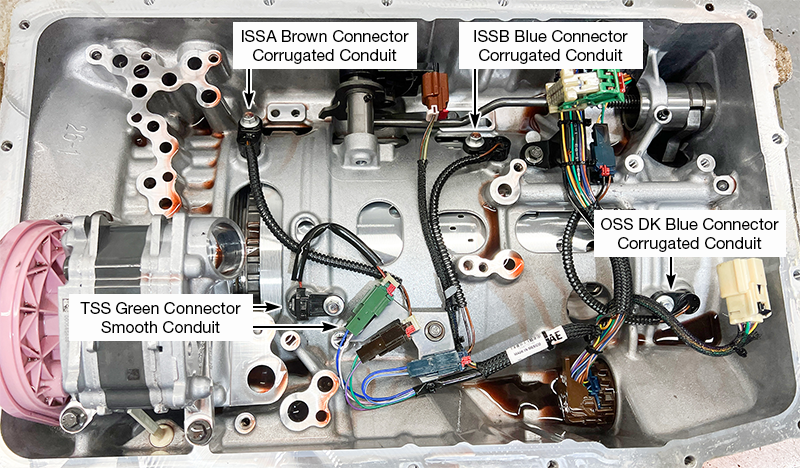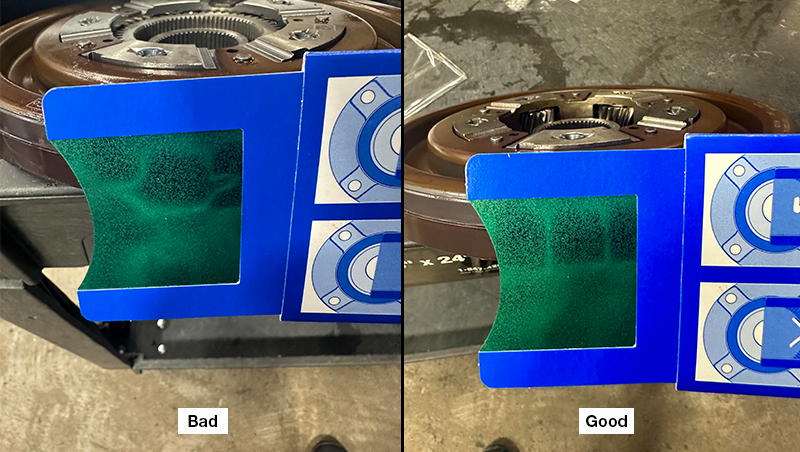March 04, 2025
Tackling Ford & GM 10-Speed Valve Body Problems, Failing Batteries & More!
Jim Mobley
Ford 10-speed “10R” transmissions utilize four two-wire, Hall-effect sensors — TSS, ISSA, ISSB and OSS — for providing speed signals to PCM or TCM (Figure 1). They are supplied 9 volts by a PCM or TCM and assist in the control of clutch apply/release timing that is used in determining shift quality, including TCC.
Listed are three conditions that you may experience with these sensors:
| Figure 1 – Correct Speed Sensor Locations |
|---|
 |
It may seem overwhelming when suddenly the transmission is in a Neutral state and you have a code appear with MIL light on. However, the necessary clues to fix these conditions are usually present in the scanner data.
Connectors are different for each sensor so only location can be swapped. The scanner is your best mode of diagnosis, simply pull up all the transmission PIDs (221+) and select specific PIDs below. Note: CDF drum issues cause ratio errors as well; this article is only about speed sensor issues.
1. For the first condition of TSS being swapped with ISSA, RPMs will be present on ISSA in Park and Neutral, but zero RPM on TSS, which is incorrect and opposite of normal state. Code P0716 will quickly appear when a gear is selected, and unit will usually be in a commanded Neutral state with MIL on. Normal operation is TSS will have RPMs in Park/Neutral, and in Reverse or Drive it will have zero RPM. ISSA and ISSB do not have RPM when the vehicle is stationary.
2. With the second condition of the OSS and ISSB locations being swapped, the vehicle will typically drive and shift at first, but soon multiple gear ratio codes will appear and the MIL light will be on. “Shift Type” may indicate FMEM state as well as gear-commanded PID. Normal operation OSS should have unit correct ratios when dividing ISS by OSS using calculator or the PID gear ratio measured. If diagnosing a specific gear range, use the same methods.
| Figure 2 – PID Gear Ratios | ||||||||||||||||||||||||||||||||||||||||||||||||
|---|---|---|---|---|---|---|---|---|---|---|---|---|---|---|---|---|---|---|---|---|---|---|---|---|---|---|---|---|---|---|---|---|---|---|---|---|---|---|---|---|---|---|---|---|---|---|---|---|
|
3. The third condition is a faulty TSS RPM reading caused by magnets breaking apart on the P2 planet. The vehicle may only drive a short distance of 40'–100', leaving little to go on. Gear ratio codes and a Neutral state may be present also. After clearing codes, a short Snap-on® scanner movie is all you get, and you can typically see incorrect ratio in 1st Gear and then it goes into a Neutral condition to protect itself. This could be an indication the P2 planet magnets that serve as the trigger mechanism for the TSS Hall-effect sensor have broken apart, especially when most other parts have been replaced previously and location of sensors has been verified. You can use an ABS test strip to check the P2 planet magnets (Figure 3). These strips are available via Amazon.
| Figure 3 – Check Magnets in P2 Planetary |
|---|
 |
Thank you to Gregory Jelvik at AA Allstar Transmission in Tucson, Ariz., and others for images and data.
Jim Mobley is a Sonnax technical communication specialist. He is a member of the Sonnax TASC Force (Technical Automotive Specialties Committee), a group of recognized industry technical specialists, transmission rebuilders and Sonnax Transmission Company technicians.
March 04, 2025
Jim Mobley
Required
Recommended
Required
Recommended
Required
Recommended
Required
Recommended
Required
Recommended
Recommended
Required
Recommended
Required
Recommended
Required
Recommended
Required
Recommended
Required
Recommended
While Sonnax makes every effort to ensure the accuracy of technical articles at time of publication, we assume no liability for inaccuracies or for information which may become outdated or obsolete over time.